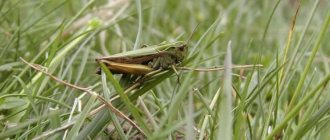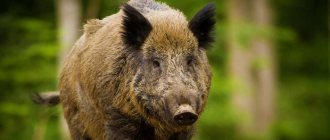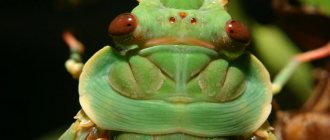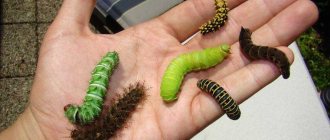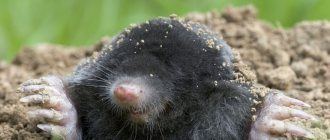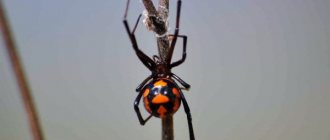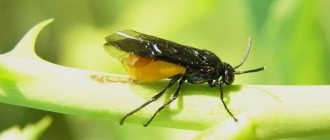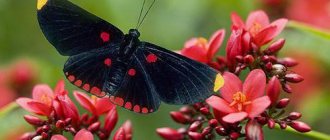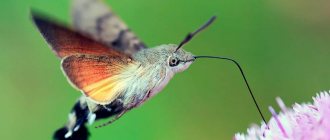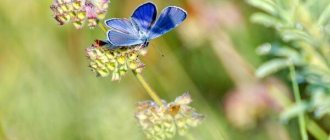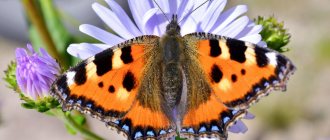The hairy caterpillar is characterized by the presence of numerous villi of different lengths throughout the body or in certain areas of it. Butterfly larvae with an exotic appearance are found more often in countries with warm climates, in the tropical zone. They have a variety of colors, differ in lifestyle and nutrition. Upon completion of their development, they pupate and a butterfly is born, which can differ significantly in color from the larva.
Where do caterpillars live?
Habitat for caterpillars
Most caterpillars live in the ground. Some of these insects live in bodies of water, while others live both on soil and in water, adapting to existence everywhere. There are two categories of larvae depending on their living conditions: secretive and free-living. The following types of larvae are classified as secretive:
Caterpillar habitat
The second variety is caterpillars that live on leaves, which they themselves eat. These are most species of larvae of the largest butterflies.
Chemicals
Measures to combat caterpillars
There are methods and techniques for dealing with cutworm caterpillars, which have already proliferated heavily on plants in the garden or garden. To do this, they use chemicals containing deltamethrin: Biorin and Super Fas, which will allow you to quickly and effectively get rid of pests. However, treatment should be carried out every 3-7 days, taking into account the different times when larvae emerge from eggs.
Another group is drugs from the neonicotinoid group: Aktara, Comfidor, which are intended to combat leaf-eating insects and larvae. They have a systemic long-term effect, poisoning pests through the green parts of plants and fruits.
In autumn, when digging up the soil, it is recommended to add hexochlorane powder (12%), which is scattered directly over the surface and then dug up.
What do caterpillars eat?
Eating caterpillars
An insect that has just been born eats the top layer of the egg in which it grew. After this, the “worm” proceeds to its main meal. Each type of larvae has its own diet. Most caterpillars eat vegetation: fruits and various green masses. Larvae can be divided into 4 categories depending on their food supply:
- Polyphages - consume all plants without exception. This species includes, for example, the caterpillars of moths.
- Oligophages - prefer to consume specific plants. For example, umbrella bushes.
- Monophagous - they eat only one type of plant. For example, silkworm larvae consume only mulberry leaves.
- Xylophages - the food base of this species is wood.
Food of caterpillars
It is worth noting certain types of caterpillars, which cannot be combined into any category, since there are few of them, but they exist:
- Caterpillars of gray or black granary moths eat only fungi of the tinder type or lichens. Poisonous spores are the main type of food for such larvae.
- There are representatives of larvae in the world that eat the outer covering of animals : particles of horns, wool, skin, hair.
- Some types of caterpillars consume wax and even honey.
- Predatory insects - there are few representatives of this species. Cases of predation occur if the population increases greatly and there is a shortage of regular food. For example, bollworm larvae attack caterpillars of their own species that are weakened or sick. Some species eat aphids, small insects and scale insects. To do this, they have special hunting devices in the form of a large mouth, sticky legs, and so on.
- Parasitic larvae settle on representatives of specific insects . Some types of larvae settle on the hairs of caterpillars. Because of this, the host insect dies.
- Certain species of caterpillars live in ant heaps . In this case, their main food is small insects. Attracting the victim occurs with the help of special sounds that the larva makes or a special sweet liquid that is secreted by its secretory functions.
Each type of caterpillar has its own diet, and it depends on the category of these larvae, their mode of existence and habitat.
Steps
Part 1
Provide a suitable living environment
- 1
Take a suitable container.
The hairy caterpillar can be safely housed in a clear plastic or glass jar. The jar must have a lid so that the caterpillar does not escape. You can also use a cardboard box instead of a jar.
Make several small holes in the lid or take a lid with ready-made holes. The holes are necessary to allow air to enter the jar.
- 2
Place a twig in the jar.
The caterpillar will need a branch to build its cocoon. Insert a small branch into the jar containing the caterpillar. The branch should lie diagonally so that the caterpillar can climb onto it when it wants to spin a cocoon.
- 3
Clean the jar regularly.
The caterpillar will leave droppings in the jar daily. It needs to be cleaned regularly. Remove the caterpillar from the jar and remove the droppings with a napkin.
- 4
Keep the jar outside.
The hairy caterpillar requires a cold environment to grow. Store the can in a safe place outside your home. A safe place for caterpillars can be a garage or shed near the house.
Part 2
Feed the caterpillar
- 1
Place the plant on which the caterpillar was found in the jar.
Caterpillars prefer plants that are familiar to them. Pick a few leaves and plants from the area where you found the caterpillar. Put them in a jar.
For example, if you find a caterpillar on a tree in the garden, pick a couple of leaves from that tree.
- 2
Feed the caterpillar leaves.
It is very beneficial for caterpillars to eat leaves. If you find a few leaves on the ground, take them and bring them into the house. Scatter them across the bottom of the jar or box containing the caterpillar. Both green and already dried leaves are suitable for this. The caterpillar needs to be fed leaves every day.
- 3
Place flowers and grass.
Caterpillars also eat flowers and grass, so pick some from outside your home. For good growth of the caterpillar, plants such as dandelions, grass, plantain and burdock will be very useful. Provide the caterpillar with fresh flowers every day.
- 4
Spray the jar regularly with water.
Hairy caterpillars do not need a container of water, especially since they can drown in it. However, the jar with the caterpillar must be regularly sprayed with water. Spray the bottom of the jar with a spray bottle every day. Thanks to the tiny drops of water, the caterpillar will not suffer from dehydration.
Part 3
Release the caterpillar
1
In winter, add fallen leaves to the jar. When winter comes, add fallen leaves to the jar with the caterpillar. They will serve as warm housing during the cold winter months. The caterpillar will eventually build a cocoon, but this will not happen until spring.
It is very important that the caterpillar does not freeze in winter. 2
Bring the jar or box containing the caterpillar into the house when it builds a cocoon.
In the spring, the caterpillar will stop moving and remain on the branch. After a while she will build a cocoon. When this happens, the jar with the caterpillar can be brought into the house. This will allow you to better see the butterfly inside.
3
Feed the butterfly when it is born. Before the butterfly emerges from the cocoon, place a few more twigs and fresh leaves in the jar. Since the butterfly will remain in the jar for several more days, it will need these food sources.
4
Release the butterfly after two days. Watch the butterfly for a couple of days after it emerges from the cocoon. Take a closer look at her and watch how she eats leaves and grass. If you have children, this will be a great learning experience for them. However, after a few days the butterfly will have to be released into the wild in the same place where you found it. For a butterfly, unlike a caterpillar, life in a box will not be as comfortable.
Body structure of a caterpillar: description, photo
Body structure of a caterpillar
Any caterpillar consists of the following body parts:
- Torso
- Head
- Breast
- Abdomen
- Pairs of legs
- Spiracle
- Mouthparts
- Eyes
The body of such an insect consists of a head, abdomen, chest and several pairs of legs.
Hawkmoth
The structure of the head of different types of insects can be different - from the most unusual with “horns” to a real imitation of other inhabitants of the Earth, for example, snakes and even fairy dragons.
Dragon Caterpillar
Snake-like caterpillar (lat. Hemeroplanes triptolemus)
Swallowtail caterpillar that looks like a snake
Pink caterpillar citheronia royal, similar to a dragon (lat. Citheronia regalis)
The head of the larvae consists of six fused segments that form a hard capsule. In the area between the forehead and eyes, the cheek area is highlighted. At the bottom of the head there is a heart-shaped occipital foramen.
Caterpillar
The head of most caterpillars is round, although it can be triangular or rectangular. The parietal part usually protrudes, forming a "horn". Antennae grow on the sides of the head.
Saturnia butterfly caterpillar
The oral apparatus of such insects has well-formed gnawing upper jaws with teeth, thanks to which the “worm” gnaws or tears food tissue. There are tubercles on the inside that help chew food. Saliva is converted into a special spinning secretion.
Caterpillar mouth
The eyes of larvae are the simplest visual system. The eye of this insect consists of one lens. The eyes are on the head and are located one after another along an arched line. Some insects may have one eye, but it has a complex structure and is fused together from five simple lenses. There may also be another eye located on the inside of the arch. It turns out that almost every caterpillar has 5-6 pairs of eyes.
Caterpillar eyes
The body of this insect is well mobile due to the soft tissues of the shell. Consists of separate departments. The anus is closed by lobes with varying degrees of development.
Torso
spiracle is a stigma that is located on the chest. In larvae living in water, the respiratory organs are tracheal gills.
Harpy
Each caterpillar has several pairs of legs, some of them ending in specific hooks. The legs, which are located on the chest, have a sole with a claw. With its help, the insect moves by protruding or retracting its abdomen.
Caterpillar legs
The body of an insect is necessarily covered with hairs, outgrowths or cuticles of various shapes: stars, needles, cones or bristles. Shaggy villi can be located either in the form of individual threads or in the form of tufted clumps on the back or tail. Almost all the fluffy caterpillars are very beautiful and then transform into the most attractive butterflies.
Yellow hairy caterpillar
Ursa Hebe
This species lives in the steppe zone and has a wide distribution area. Butterflies are found in central and southern Europe, Transcaucasia, Asia Minor, Mongolia, China and many other countries. On the territory of Russia, individuals can be found in Siberia, the Caucasus, Crimea, Central Asia and Kazakhstan.
Outwardly, it is a black caterpillar, on the body of which there is a large number of long dark gray hairs. On the sides these fibers have a more orange tint. They feed on dandelions, plantain, milkweed, millennial, and thyme.
Thus, the caterpillars of butterflies of the bear family are characterized by an unusual appearance, which helps them camouflage in different territories. To protect the caterpillars there are poisonous fibers. This allowed the individuals to maintain their populations. For agriculture, the gluttony of caterpillars poses a real danger and requires the use of additional measures to prevent eating crops.
Caterpillar development: description, photo
Development of a caterpillar
Depending on the species, a butterfly larva can transform into a flying beauty from several weeks to several years. In the northern regions, the warm season does not last long, so the life cycle of the caterpillars can last two years. Some types of larvae live in the caterpillar stage for up to 12-14 years.
During its development, the larva changes in size and appearance. For example, from an ugly and naked larva it turns into a fluffy caterpillar. The caterpillar then turns into a chrysalis, from which a beautiful butterfly then emerges.
Subspecies
- Cossus cossus cossus
- Cossus cossus albescens
Kitt, 1925 (Kazakhstan, Russia) - Cossus cossus araraticus
Teich, 1896 (Azerbaijan, Georgia, Turkey, Iran) - Cossus cossus armeniacus
Rothschild, 1912 (Turkey) - Cossus cossus chinensis
Rothschild, 1912 (China: Shaanxi) - Cossus cossus dauricus
Yakovlev, 2007 (Russia: Transbaikalia) - Cossus cossus dersu
Yakovlev, 2009 (Russia: Primorsky Krai) - Cossus cossus deserta
Daniel, 1953 (Mongolia) - Cossus cossus gueruenensis
Friedel, 1977 (Asia Minor) - Cossus cossus kopetdaghi
Yakovlev, 2009 (Turkmenistan) - Cossus cossus kossai
Wiltshire, 1957 (Jordan, Iraq) - Cossus cossus lucifer
Grum-Grshimailo, 1891 (Tibet) - Cossus cossus mongolicus
Erschoff, 1882 (Mongolia) - Cossus cossus omrana
Wiltshire, 1957 (Iraq, Iran) - Cossus cossus tianshanus
Hua, Chou, Fang & Chen, 1990 (Kazakhstan, Kyrgyzstan, Uzbekistan, Tajikistan, Afghanistan) - Cossus cossus uralicus
Seitz, 1912 (Uralsk)
Transformation of a caterpillar into a butterfly: description, photo
The pupa is usually cylindrical or round in shape. The color of the cylinder is monochromatic - green or light green. It may have a pattern on the surface in the form of stripes, dots or spots. When a butterfly is in the pupa stage, it already has wings, legs and a proboscis.
Caterpillar pupa turns into a butterfly
Parasa indetermina
The larva of the Parasa indetermina butterfly, due to its unusual appearance and ability to burn, received the nickname “Burning Rose”. It grows no more than 2.5 cm, and its range is limited to the North American continent.
She has bright colors and various stripes can be seen on her body. Red and yellow spots. In addition, for protection, it has a number of processes on which there are burning tubercles. When touched, the tips of these tubercles break off, and severe pain and irritation are felt at the point of contact.
It feeds on the leaves of fruit trees, especially often affecting various varieties of apple trees. Also found in deciduous forests.
By the way, on our website most-beauty.ru there is an interesting article about the most beautiful butterflies in the world.
Beautiful caterpillars: name, characteristics, what it looks like, what kind of butterfly it turns out, description, photo
Nature has made even certain types of caterpillars beautiful so that we can admire their uniqueness. Their luxurious hairs and interesting colors delight you and you want to look at such a natural phenomenon without taking your eyes off.
Beautiful caterpillars
Saturnia Io
Saturnia Io (Automeris io) is a beautiful caterpillar with green hairs in the form of pompoms. It is impossible to even imagine that a larva with such a color turns into a red butterfly. She seems to look with her black eyes located on her pink-yellow lower wings.
Blue Morpho Blue Morpho
Blue Morpho - it is impossible to pass by at the sight of such a caterpillar. I want to look at every color stroke on the surface of her body. She is a dream for any artist. Transforms into a small blue butterfly.
Slug
Slug butterfly
Slug worm (Isochaetes beutenmuelleri) - looks like an ornament that is made of blue glass covered in fake snow. The fabulousness of this caterpillar is given by the fibers in the form of needles. They seem to be covered with real frost. The butterfly is a regular brown moth.
Coquette / Megalopyge opercularis
When you see such a creature in nature, you might not immediately guess that it is a caterpillar. The larva, covered with a kind of fur, looks more like a furry animal. This is the larva of the flannel moth, native to the southern states of the United States.
But it is not recommended to iron it. Under its hairs are poisonous spines that release a toxic substance when touched. The touch is quite painful, and after about five minutes redness may appear.
This feature is necessary for protection. Attentive nature lovers have noticed that the hairy caterpillar bears a striking resemblance to Donald Trump's hair.
Caterpillars with spikes: name, characteristics, what it looks like, what kind of butterfly it turns out, description, photo
Caterpillars with spikes do not look intimidating. They are beautiful, bright and interesting, you can look at them for hours. But it is better not to touch such caterpillars with your hands, since many species can be poisonous, and the spines are their weapon for protection from the enemy, through which they release poison.
Tracks with spikes
Butterfly caterpillar with spines
Caterpillar "Burning Rose" - its spines are located on the cuticles of the body. As it develops, it turns into a delicate moth with iridescent beige and greenish wings.
Aglais urticae
Butterfly Aglais urticae
The spiny Aglais urticae - a caterpillar that looks like a piece of black coal turns into a beautiful Peacock butterfly - bright and with an interesting color. Lives in America and mountainous forests of Asia.
Dryas Julia
Dryas Julia - Attacus atlas caterpillar is a brown and white caterpillar with black spines. Lives in Thailand and the island of Java. It turns into one of the largest butterflies in the world, with a wingspan of up to 25 centimeters.
Penetration methods
As mentioned earlier, caterpillars can enter the apartment along with food in the kitchen. However, in addition to this, pests can be seen in other parts of the house.
- If the owner finds white caterpillars with a yellow tint in his apartment, then most likely furniture moth larvae have infested the furniture. They can also be detected by their fabric cocoons, which contain small white balls that look like dark rice. These insects can enter the house with purchased furniture. If the warehouses had unsanitary conditions suitable for insect life, then the larvae “came” to the house from there. The maturation stage of furniture moths is 3 months. The larvae grow at temperatures from 20 to 25 degrees. Apartment owners may not know about new neighbors for a long time, so when purchasing furniture you should carefully check the interior upholstery.
- Also, with the purchase of furniture, flea larvae can enter the house. They are not terrible for people, since they feed on dead human tissue, hair or synthetic fabric, which is a lot of furniture. When fleas grow up, they become dangerous to humans because they begin to drink blood. They can also be brought into the house with vegetables and pet products (rugs, bedding). If the house is old, then the larvae like to hang around in wooden planks.
- Pests are found in new mattresses and pillows. Clothes moth larvae look like small white worms with 6 pairs of legs. They can be identified by the silk case in which they live. They feed on the remains that humans leave behind: sweat, greasy food stains, hair.
- Carpet beetle caterpillars can get into your home with new carpet. Their elongated body has alternating brown and golden stripes. These larvae are found in clothing and pillow feathers.
- You should not take old furniture from your hands. If necessary, the boards should be checked. Caterpillars of grinder beetles can live in them. They live in the same furniture for about 20 years. They are very harmful to wooden materials and can then climb into other furniture. The larva is distinguished by its gray, fleshy body with spines on its head. Over the course of its entire life, this insect can chew through 50 km of wood.
- Due to dampness in the toilet and bathroom, silverfish larvae settle on the ceiling and walls. They have a white or silver body with a black shell. They don't like light, so they prefer the gaps between baseboards. Such insects live for 4 years and reproduce very quickly.
- If the kitchen is not clean, in addition to food moths, fly caterpillars may appear. They look like white worms. They are very dangerous because they spread infections. You should get rid of such neighbors immediately after discovering them.
Poisonous caterpillars: name, characteristics, what it looks like, what kind of butterfly it turns out, description, photo
A person should be wary of poisonous caterpillars. You cannot pick them up or even come close. Many species cause a burning sensation on the skin upon contact with the insect’s body, while others can even be life-threatening: breathing rhythm is disrupted, heart palpitations, headaches, and so on occur.
Poisonous caterpillars
Poison caterpillar butterfly
Flannel Moth - This poisonous caterpillar looks like a small hamster. Her butterfly is no less beautiful. But it is strictly forbidden to touch it with your hands, as it causes an allergic reaction and even a feeling of suffocation.
Lazy clown caterpillar
Lazy clown caterpillar butterfly
The “lazy clown” caterpillar (lat. Lonomia obliqua) lives in Uruguay. A highly poisonous insect that secretes a special natural toxin. The venom of this caterpillar causes skin burns. In addition, the toxin can penetrate through the skin to internal organs and cause hemorrhage, for example, in the gastrointestinal tract, kidneys, and also causes pulmonary edema and disruption of the central nervous system.
Saturnia Mayan caterpillar
Saturnia Maya caterpillar butterfly
Saturnia Maya caterpillar (Hemileuca maia) -
covered with hollow spines, upon contact with which, a burning sensation on the skin, rash and nausea appears.
The appearance of this caterpillar should be frightening, because a crawling, hairy insect with black spines will disgust any person. This caterpillar lives in our latitudes on oaks and willows. The butterfly from this caterpillar is also black in color with a hairy body, but it is not poisonous. Volyanka caterpillar
Orgyia leucostigma
caterpillar butterfly
— you won’t be able to pass by such a caterpillar, since it is noticeable thanks to its red head and white body.
Eats everything green and woody in its path. If you touch the hairs of this insect, burns and irritation immediately occur. The rash may not go away for several weeks. White cedar moth caterpillar
White cedar moth caterpillar butterfly
White cedar moth caterpillar (leptocneria reducta)
- lives on a cedar tree in several groups at the same time, eating every single leaf. Contact with the hairs of this caterpillar causes irritation, but not for all people. If a person has sensitive skin, they will most likely feel a burn and develop a rash.
Remember: Beautiful caterpillars are almost always poisonous. Their bright colors are designed to scare away predators. Therefore, if you see, for example, a blue caterpillar with an orange head or a green caterpillar with bright red, blue or black spots, try not to touch such insects with your hands and move away from them.
Appearance of hairy baby butterflies
Photos and names of furry caterpillars are presented below. The variety of butterflies and their larvae, colors, and appearance is surprising.
- Yoke. Outwardly it resembles a miniature, harmless, fluffy or hairy animal. However, hidden under the attractive coat are thorns with quite strong poison. Within 5 minutes after touching a strange creature, a throbbing pain appears in the armpit. This is followed by general malaise and signs of intoxication of varying severity. The area touched by the hairy baby butterfly becomes covered with red spots and a rash.
- Traveling silkworm. A black furry caterpillar lives high on a pine tree. Hairy creatures settle in numerous colonies in a large silken nest. Butterflies lay eggs in huge numbers. They feed on the juices of needles and move together in a colony, following one after another. The entire body is covered with hairs and contains poison inside. Touching a person ends in irritation of the skin, and signs of intoxication may be present.
- A hairy caterpillar hiding in a sac. The name of the black hairy caterpillar characterizes its lifestyle. During the day, the larvae hide en masse in a special silk bag, which they form for themselves. At night they move in groups in search of food. They resemble the appearance and lifestyle of traveling silkworm larvae, but are more dangerous to humans. The large hairy caterpillar contains anticoagulant poison, which prevents blood from clotting and can cause internal bleeding. The butterfly is absolutely safe.
- Ursa crusadus. The black and orange hairy larva is dangerous due to the consumption of large quantities of juice from a poisonous plant - ragwort. In North America, butterflies and their offspring are used to destroy harmful plants in the area. The hairy caterpillar is dangerous for cattle and horses. An animal can die from its presence on the body. It brings a temporary deterioration in health to a person.
- Witch moth. Brown, shaggy, unusual shape. More like a flower with petals. Lives in orchards, feeds on the juices of plants and vegetables. It does not pose any particular danger to humans, but after touching, a rash, redness, and itching are observed.
- Volnyanka. The furry black-and-red caterpillar has a red head. The body is black, with red stripes with spikes on the sides. The red color of the head warns of the danger of a small creature. The pest lives on trees and eats the bark. With a large number of larvae, the plant risks dying. You should not remove the caterpillar from the tree with your hands; the larva stings unpleasantly, causes an allergic reaction on the skin, and general malaise.
- Saddle-haired. A red caterpillar with a light green pattern. Outwardly it resembles a dog in bright clothes. Muzzle, tail, back. The light green pattern on the body looks like a saddle. This is where the name comes from. An attractive hairy creature is dangerous to human health. There are spines with poison on the fleshy horns on both sides of the body.
The furry caterpillar goes through several stages of development and molts from 2 to 6 times during its maturation. At different stages of development, it can differ significantly in appearance - from naked to shaggy, from hairy to smooth.
The insect class is one of the most diverse and numerous representatives of living beings inhabiting the globe. The most beautiful representatives of the family are butterflies, which differ from each other in the most diverse and intricate patterns located on their wings. Caterpillars are an integral natural target for the formation of butterflies. They also come in a variety of shapes and colors.
Interesting facts about caterpillars
Caterpillars are amazing insects. Ordinary people don’t know much about them and think that they are ordinary worms that crawl through trees. Only entomological specialists know everything about caterpillars. Here are interesting facts about these insects:
- Entomophagy, or the eating of insects, has flourished on Earth since ancient times. Caterpillars occupy a place of honor among gourmets. They are eaten raw, dried, fried, with sauces, and omelettes.
- The silkworm caterpillar is specially bred in many countries. From 100 kg of cocoons, 9 kilograms of silk thread are obtained.
- The color of any caterpillar imitates the living conditions of this insect. This is an excellent means of camouflage and protection.
- The caterpillar's body contains 4,000 muscles. For comparison, a person has only 629 of them.
- During the first two months of life, the caterpillar eats a lot of plant food, which helps it increase in size up to 20,000 times its original weight.
- Caterpillars that live in northern latitudes do not have time to complete the entire development cycle in one season, and therefore they remain overwintering in cocoons. It is worth noting that in this state the caterpillar can withstand frost temperatures down to -70 degrees.
- Some types of caterpillars live in anthills, making special sounds and secreting enzymes. The ants think that the caterpillar is their queen, so they feed it and take care of it.
- Certain species of caterpillars become poisonous due to the food they eat. For example, the caterpillars of the moss bear feed on poisonous ragwort. Their body begins to release toxins, making these insects a threat to animals and people.
Caterpillars are amazing creatures of nature. There are many different species, and almost all of them turn into beautiful and graceful butterflies that adorn our lives.
Tips and tricks
Unfortunately, none of the described means and methods of dealing with voracious aliens guarantees 100% deliverance from this scourge. It is best to prevent caterpillar attacks and eliminate the consequences of their invasion. These simple rules will help preserve your crops and garden:
- Provide plants with proper care. If you don’t know how to monitor certain crops, don’t be lazy and read the specialized literature.
- Try not to oversaturate the plantings, so that each plant is well ventilated and illuminated;
- Carefully inspect new shoots and seedlings for disease and pest damage;
- From time to time, weed the beds and loosen the soil;
- Fertilize plants with organic and mineral fertilizers in a timely manner.
Following these rules will help keep your garden in excellent condition, which will delight you with a rich harvest.
Lifestyle of wood borers
This is a sedentary species, leading a nocturnal lifestyle. Flight occurs at the end of May - beginning of August. On the Black Sea coast, in warm weather, flights can begin in mid-April. In Transcaucasia it runs from May to July, and in Tuva and Buryatia from June to August. Willow woodborers fly low above the ground. The flight lasts about 2 weeks, mainly at night.
These butterflies are more active at night.
Purple Hawkmoth / Mimas tiliae
The small caterpillar reaches an average length of no more than 6 cm at the peak of development. The species of this inconspicuous butterfly was discovered by Carl Linnaeus in 1758.
The body is rough, and there is a horn on the tail. This horny process has a protective shield. Development begins in early summer. During this period, they can be found on the branches of wild and fruit trees. There are especially many of them on linden, birch, and various types of alder. By the time of pupation, the body color completely changes.
It is not dangerous in itself, but if it crawls across the body, it will leave a bright mark. There are substances on her body that cause an allergic reaction. It is most difficult for allergy sufferers and people with weakened immune systems.
Witch moth / Phobetron pithecium
The most peculiar and unusual caterpillar in wildlife usually lives on fruit trees in orchards. Because of its unusual appearance, it is also called the “slug monkey.”
The entire body is covered with thick hair, and the body structure differs from the usual physique of butterfly larvae. Most often, the hair is light brown in color, which darkens with age.
Nature took care of protection, because not every bird will decide to peck such a “monster”. This type of larva can be perceived in different ways, but the hairs contain a toxic substance. If it comes into contact with the skin, it causes redness that goes away after a few days.
Volyanka / Orgyia leucostigma
Small butterflies have settled on all continents, and in total there are more than 2,700 species. Particularly large populations are found in the tropical and subtropical zones of Southeast Asia and the African continent.
The caterpillars of many species of mothwort are poisonous. There are hairs on the body that contain a toxic substance. During periods of mass reproduction, such larvae can cause great harm to animals and humans. The poison causes inflammation of the respiratory tract, affects the mucous membrane of the eyes and causes a rash on the skin.
In addition, they are polyphagous and cause great harm to garden crops. They develop both on trees and on shrubs and herbaceous plants.
Literature
- Zagulyaev A.K. Sem. Cossidae - Woodworms or cossids. / Insects and mites are pests of agricultural crops. T. 3, part 1. Lepidoptera. - St. Petersburg: Nauka, 1994. pp. 47-51.
- Rudnev D.F. Woodworm family - Cossidae. / Arthropod pests of agricultural crops and forest plantations (ed. Vasilyev V.P.). T. 2. - Kyiv: Harvest, 1974. P. 226-228.
- Savkovsky P. P. Atlas of pests of fruit and berry crops. - Kyiv: Harvest, 1976. 207 p.
- Chistyakov Yu. A. Woodworm family - Cossidae. / Butterflies are pests of agriculture in the Far East. Determinant (ed. Kirpichnikova V. A., Ler P. A.). - Vladivostok: Far Eastern Branch of the USSR Academy of Sciences, 1988. pp. 55-60.
Prevention measures
To prevent woodworm from appearing in the garden area, it is best to take preventive measures. They consist of regularly clearing trees of moss and cracked bark. To preserve trees, you will need to lubricate the trunk using any of the following mixtures:
- Mix clay (2 parts) with lime (1 part).
- Prepare a product from insecticide, glue and clay. To do this, dilute the clay in a bucket with water to such a consistency that it resembles sour cream. Then add 10% Karbofos and 250 g of carpentry or casein glue. If the trees are young and their bark is very thin, you should not add glue.
The selected mixture should be used on days when there is no rain. The frequency of application is twice per season: in the spring, when there is still snow cover, and in the fall, after the leaves have fallen. It is necessary to coat not only the tree trunk with the mixture, but also the base of the branches. Coating height is 2 m or more.
Redtail / Calliteara pudibunda
The distribution area of this butterfly is quite wide, but is divided into two large regions. The first, these are the countries of Western Europe, is found in Belarus and Crimea.
The second is the eastern regions of Russia. Widely settled in Siberia and Primorye. It is also called Shy Paw. The entire body of the caterpillar is covered with hairs, and the color is quite varied. There are red, pink, as well as brown and gray individuals. But they all have a small red ponytail at the back.
Touching human skin causes an allergic rash and redness. A furry caterpillar will not do much harm, but it will be unpleasant.
Saturnia io (Automeris io)
One of the types. Caterpillars at the first stage are reddish in color. Later they change color to green, becoming like the “catkins” of some trees. The top photo shows Saturnia io at an older age, the bottom photo shows larvae in the first stage of development.
The caterpillars are protected by spikes containing strong poison, which is released at the enemy at the slightest danger. Contact with this poison leads to erucism: toxic dermatitis. Erucism is characterized by the following features:
- blisters;
- strong pain;
- lymphangitis;
- edema;
- skin necrosis.
Sometimes tissue death occurs with erucism.
But all these dangers live in quite exotic countries and not every Russian tourist will encounter them. But there are three species of butterflies whose offspring you can stumble upon when leaving your home in your homeland. The poisonous caterpillars of Russia do not pose a mortal danger, but they can cause a lot of unpleasant impressions.
Ochrogaster lunifer
This type of caterpillar is called "hiding in a bag." They stay in groups in a silk bag during the day, and at night they crawl out to hunt, moving one after another.
The species lives in South America and poses a danger to humans. The black caterpillar is completely covered with sharp hairs. They are not poisonous, but touching them can cause a deep cut.
The whole danger is that these hairs act as a powerful anticoagulant. This substance slows down the process of blood clotting. To avoid big problems, it is necessary to provide medical assistance.
Pest detection
The fragrant woodborer is found where poplar, birch, maple, willow and other trees with soft wood grow. Fruit trees also suffer from insects: in addition to apple trees, pears, plums, and cherries, insects damage nut trees and olives.
Usually the pest settles on weakened or lonely growing trees. Damaged plants after such residents weaken and are easily affected by fungal and bacterial diseases.
Due to the gnawed passages, young shoots dry out en masse and leaves fall off. This causes the fruit yield to sharply decline, and ornamental plants become unattractive. Weak trees are stunted and may dry out and die. Here are the consequences of what will happen to plants if you do not fight such a pest as the fragrant wood borer. Photos will help you understand better than any words how serious this “passenger” is.
The following signs will tell you that the woodworm has settled on the plants:
- The presence of passages on the trunks. They are quite wide and oval in shape.
- The appearance of drill flour. These are small sawdust that spill out from the gnawed passages. If the bark is damaged, the sawdust will be brown, and if the damage is deeper, its color will be yellowish.
- Drying or detachment of the bark from the trunk.
- The leakage of brown liquid mixed with pest excrement from holes in the tree. Moreover, the liquid will have a pungent odor.
- Having inhabited one tree, the caterpillars crawl to a neighboring plant. During this period they can be seen on the soil surface.
The most effective way to combat the pest is to remove or destroy the larvae at a time when they do not emerge from under the bark of trees. For this purpose, mechanical, chemical or biological methods are used. Below are the features of each of them:
- Mechanical destruction is the collection of larvae in those areas of plants where the bark has fallen away from the trunk or has died off altogether. To do this, you will have to do all the work manually, since no devices can be used so as not to damage the wood. The only thing you can do is wear gloves. After completing the work, you need to burn the collected larvae along with the peeled bark. Cover any damage found on the tree with garden varnish.
- Chemical method. Involves the use of organophosphorus insecticides. This may be “Chlorpyrifos”, “Chlorophos” and others. You need to wet a cotton ball with any of the preparations, and then find the move that the caterpillars made and put the cotton wool inside. A more simplified option is to inject an insecticide into the holes made with a douche or syringe.
- The biological method works best if the woodworm has settled in the garden. Control measures in this case consist of attracting birds to the garden. Of course, only those that feed on insects - magpies, woodpeckers, rooks, tits and many other representatives of birds happily eat pests, including the caterpillars of the odorous woodworm. In order for birds to settle in the garden, you need to think about this in the fall - hang up artificial nests, houses, feeders.
Trees favored by woodworms become sick, and may die if infested en masse. This happens rarely, but in order to prevent damage to fruit trees, the trunks are whitened with a special emulsion, which protects the bark from cracking and the introduction of larvae. The external openings of the passages are filled with cotton balls soaked in insecticide, or liquid is injected into the cavity. The hole is covered with garden varnish, a mixture of clay and slaked lime.
The trunks are mechanically cleaned of fallen bark and caterpillars. Damaged branches are cut off. If the tree is severely damaged, it is removed and the collected caterpillars are burned.
We suggest that you familiarize yourself with what kind of screws for drywall
Some insect lovers grow woodworms at home because of the large and colorful caterpillars. Despite the fact that the willow woodborer is a pest, it is interesting to study it as one of the largest species of moths.
Notes
- Vorontsov A.I. Forest entomology. — 4th ed., revised. and additional.. - M.: Higher School, 1982. - 384 p.
- Mirzoyan S. A., Batiashvili I. D., Gramma V. N. et al. Rare insects M.: Forest industry, 1982. - 165 p.
- ↑ 12
Shevyrev I. Ya. Scented woodborer // Encyclopedic Dictionary of Brockhaus and Efron: in 86 volumes (82 volumes and 4 additional). - St. Petersburg, 1890-1907. - Striganova B. R., Zakharov A. A. Five-language dictionary of animal names: Insects (Latin-Russian-English-German-French) / Ed. Doctor of Biology sciences, prof. B. R. Striganova. - M.: RUSSO, 2000. - P. 200. - 1060 copies. — ISBN 5-88721-162-8.
- Krushen-woodborer // Encyclopedic Dictionary of Brockhaus and Efron: in 86 volumes (82 volumes and 4 additional). - St. Petersburg, 1890-1907.
- Vasiliev V.P. Pests of agricultural crops and forest plantations: In 3 volumes - Vol. 2. Harmful arthropods, vertebrates. — 2nd ed., rev. and additional / Under the general ed. V. P. Vasilyeva; Editors of the volume V. G. Dolin, V. N. Stovbchaty. - K.: Urozhay, 1988 576.
- Scarlato O. A. Key to insects of the European part of the USSR. Volume IV. Lepidoptera. First part. A. K. Zagulyaev, V. I. Kuznetsov, A. A. Stekolnikov, I. L. Sukhareva, M. I. Falkovich. L., “Science”, 1978, 712 p.
- Butterfly pests of agriculture and forestry in the Far East: Key. Ed. Belyaev E. A. et al. Vladivostok: Far Eastern Branch of the USSR Academy of Sciences, 1988
Baang haang
This is the name of the caterpillars of Thailand. We will complete our list of most-beauty with them. Almost all caterpillars of an exotic country will cause a lot of problems for tourists. After meeting them, the body itches for weeks and a rash appears.
Like many inhabitants of tropical forests, the larvae of Thai butterflies are beautiful and distinctive. Most species are brightly colored to scare off enemies. Some, on the contrary, disguise themselves as foliage or the earth's surface.
When going to any country, you need to study what dangerous creatures you can encounter in its open spaces.
